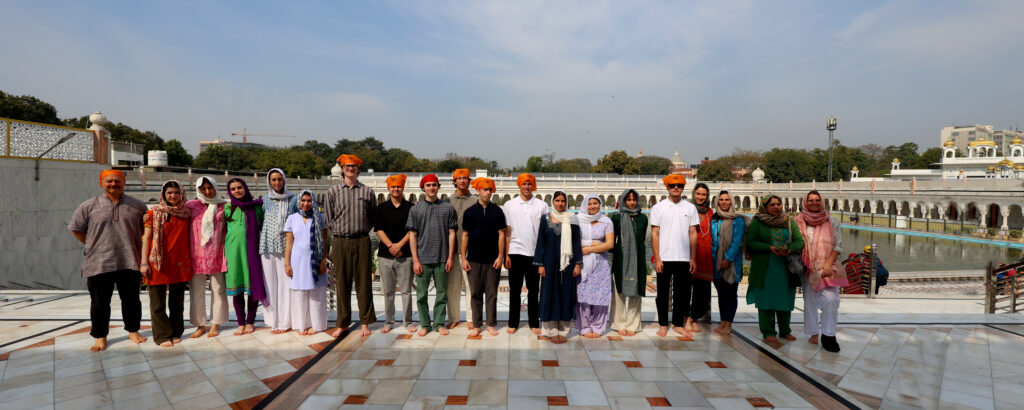
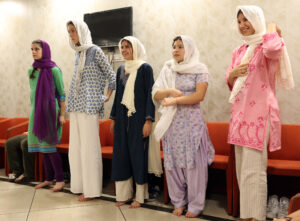

First day in India. It was surreal, and it took a bit of time and taking in the surroundings to process we were in a different country. What struck me most, and immediately, was how different the plants growing here are, and how different it makes the landscape feel. There are stray dogs almost everywhere, cows in the street, the occasional monkey, the crows are grey and black, there are parrots, and flocks of what look like hawks flying around. Cars are honking at all hours and it’s incredible how easily drivers navigate through the chaos. Our tour guide, Ravi, was so funny and we all enjoyed his manner of speaking. He cracked jokes, and told us so much information, answering questions we didn’t even know we had.
The first place we visited was a Sikh Temple. It was massive and colorful, and there was singing the whole time. We had to cover our heads and go barefoot. The removal of shoes made it feel like we were closer to the earth. In the temple, they serve free food to anybody who asks for it, regardless of religion, sex, and race. You can even go back for seconds or thirds or however many times, no questions asked. I think that is a beautiful part of how giving some religions are. In the temple, we were allowed to help prepare food. Cy, Logan, Chelsea, Irulan, and I got to roll out the dough. We sat side by side with complete strangers, touching elbows, as they gave us tips on how to work more efficiently. The man working next to me didn’t speak to me, but he would point, and demonstrate rolling strategies, and occasionally sprinkle flour on my dough when he deemed it necessary. Chelsea commented on how it was amazing that we didn’t have to sign any waivers to be able to do volunteer work, and how it may encourage people to help more if there weren’t so many steps you had to take. You can see that volunteering here is ubiquitous that leads to nobody questioning motives. That was the biggest takeaway from the day, that volunteer work does truly matter and you gain a sense of purpose from participating.

The sun sets in an orange glow. Despite the thickness, the blue sky peeks out from beneath the haze. Our teacher Shannon tells us that this is one of the few times she’s seen the sky this clear, in fact, in her seven trips she can count all the clear days on one hand. The air pollution was something I had expected coming onto this trip but everything else I have experienced on my first day here has been novel.
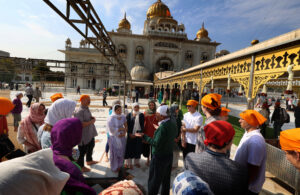
We began our day at the Sikh Temple, a gorgeous place made of intricate marble. Paths made of mats and turf zig-zag across the cool floor for its visitors to walk across. We follow our tour guide, barefooted, and with our heads covered. Before entering the temple, we step both feet in holy water. Inside, the smell of fragrant flowers wafts from garlands. Sunday is the temple’s busiest day with swarms of people visiting and receiving food, a place called Langar. From the middle of the temple’s plaza, lies a tall post covered in orange cloth that indicates the surrounding areas where one can receive food. Beside the temple stands a volunteer who distributes Kada Prasad, a pudding made of wheat flour and ghee shaped into a small ball. Our tour guide instructs us to rub our hands together after eating the pudding to rub the ghee into our skin like lotion. Our first of many times we found a reason to use our hand sanitizer.
At lunch, we talk with Radha, a Sri Ram Ashram alumni. Her humor is contagious and it’s hard not to laugh. As we scan the very western menu and I sip my coffee (yes, coffee), we pester her with questions that she thoughtfully answers. Radha tells us about her current job working with an NGO. At the NGO they cover a variety of subjects but at the table, we mainly discuss feminine hygiene. She shows us an animated video with a song that tells the story of the egg in a woman’s menstrual cycle that the NGO has created. In India, discussion around topics such as menstruation and sex is very taboo. Because of this, there are many misconceptions and myths that undermine safe and healthy practices. The NGO that Radha works for found that creating music was one of the best ways to inform people who do not want to have discussions about such topics.
Later, at the bazaar, Bella Sol and I wander about trying to find gifts for our family. At each stall we try out our bargaining skills. We find that the best strategy is asking for low prices and then walking away acting as if we’re not interested. Immediately they call after us with an even lower price. If a vendor got too aggressive we slipped into Spanish, which quickly became our secret language.
At the end of the day on the bus ride to the hotel, we played Where’s Waldo but the Modi version. A game which Radha laughs at because it’s the easiest game in the world since Modi is quite literally everywhere. On every street lies a billboard, poster, cutout, or flag of Modi. Radhas laughter at our game acts as a motif for our trip, since we still have so much to learn and experience in this country.

Today was the first day of our India adventure. We started the morning off with a bus ride with our incredible tour guide, Ravi to visit a Sikh temple. Ravi was such a nice man and truly embodied the warmth and hospitality intertwined in Indian culture. On our ride over to the Sikh temple he taught us about the Sikh religion and that Sunday was the busiest day and to be prepared for lots of people. One of the major parts of Sikhism is to give back to the community. The temple feeds thousands of people of all religions and backgrounds daily. Today we had the opportunity to help in the kitchen and feed the community. It was so beautiful to see people take a day of worship, listen to prayer, and share a meal together.
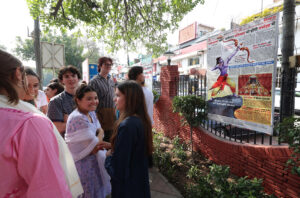
The entire city of New Delhi is so vibrant and full of life. The bus rides have been the perfect way to observe the city though admittedly, a bit scary. Here in the city, the rules of the road are merely “suggestions”. All different types of vehicles are on the roads trying to get to their destinations without any regard to pedestrians or other vehicles. The first thing you notice about being in the city are the constant beeps of the cars, buses, and motorcycles trying to communicate with each other.
When I first heard we were going to the most populated city in India, I expected myself to get overwhelmed easily. Instead, I have never been more curious in my life. My eyes are constantly scanning the roads and streets looking for any action to follow. Everything is so new and exciting. Vendors by their shops advertising their goods, pedestrians attempting to cross the street while coming alarmingly close to vehicles, and animals such as cows, monkeys, and dogs on the streets walking among the locals. It has been so interesting noticing the similarities and differences between the U.S and India. I can’t wait to see what else the next two weeks will bring.

The streets of Delhi are full, not only with cars, but with people, dogs, monkeys, and cows too. Despite the constant assurances that you just have to ignore the road, it’s hard to get used to how close you seem to car accidents every few seconds. The amount of people here is incredible. But despite the sheer amount of people and creatures, pockets throughout the city are almost hauntingly empty. It’s a stark contrast to the hustle and bustle of the rest of the city. Squares and street corners will be full of people standing shoulder to shoulder, but the next block will have a little abandoned bungalow. The amount of people in need of shelter here makes me wonder what, about these little, seemingly empty pockets, wards them off. It’s interesting how we take for granted the amount of space we have in Santa Cruz, always complaining about how too many people are moving here, or how the traffic is terrible, when the streets of Delhi are gridlocked.
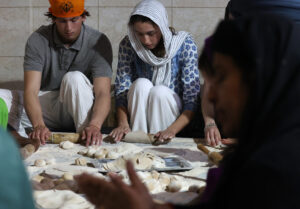
People here seem kind. Our tour guides, restaurant employees, and other pedestrians alike all felt very curious to meet you and also eager to help with whatever you need. When visiting the Sikh Temple, we volunteered in the kitchen. 90% of the workers are volunteers, cooking and serving food to anyone and everyone. There is no judgment . People sit on the floor, side by side, to eat the same meal no matter their caste, religion, gender, or wealth. I’ve never seen something so uniting. In the kitchen, I sat amongst women old and young and rolled out dough to be fried. The women were eager to show us the right way of doing things, and scooted over to let us take a seat while we worked. My class came out of the kitchen fulfilled despite the fact that we hadn’t eaten anything
We had a clear day here in Delhi with blue skies. There are colorful birds lining the trees and monkeys lining the gates. It’s a city rich with diversity, different religions, cultures, and so much more. To put it into words is difficult. I appreciate the lack of graffiti as beautiful artwork lines the streets instead. It’s so thoughtful. Even though it’s still shocking to see young children collecting garbage to sell and The air is hard to breathe, despite the clear sky today, efforts are being made to clean up and city buses are becoming electric. I wish we were staying another day, to visit the gardens or ruins or museums that we spot from the bus. I am excited to see Dharamshala as I’m curious how different Dharamshala will be from here, like here is from home.
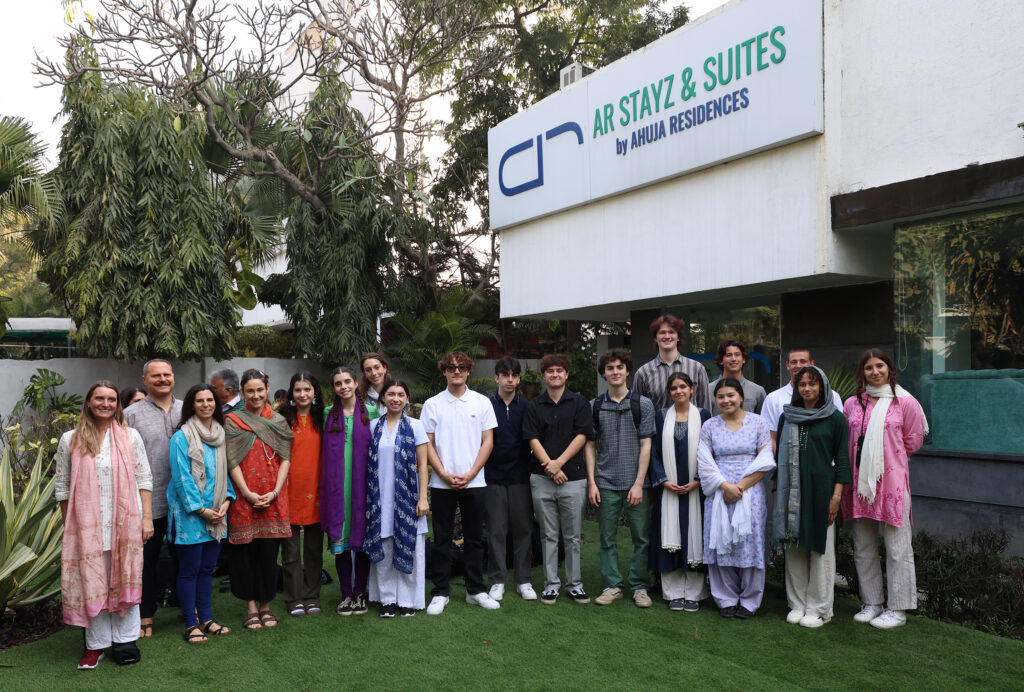
You must be logged in to post a comment.